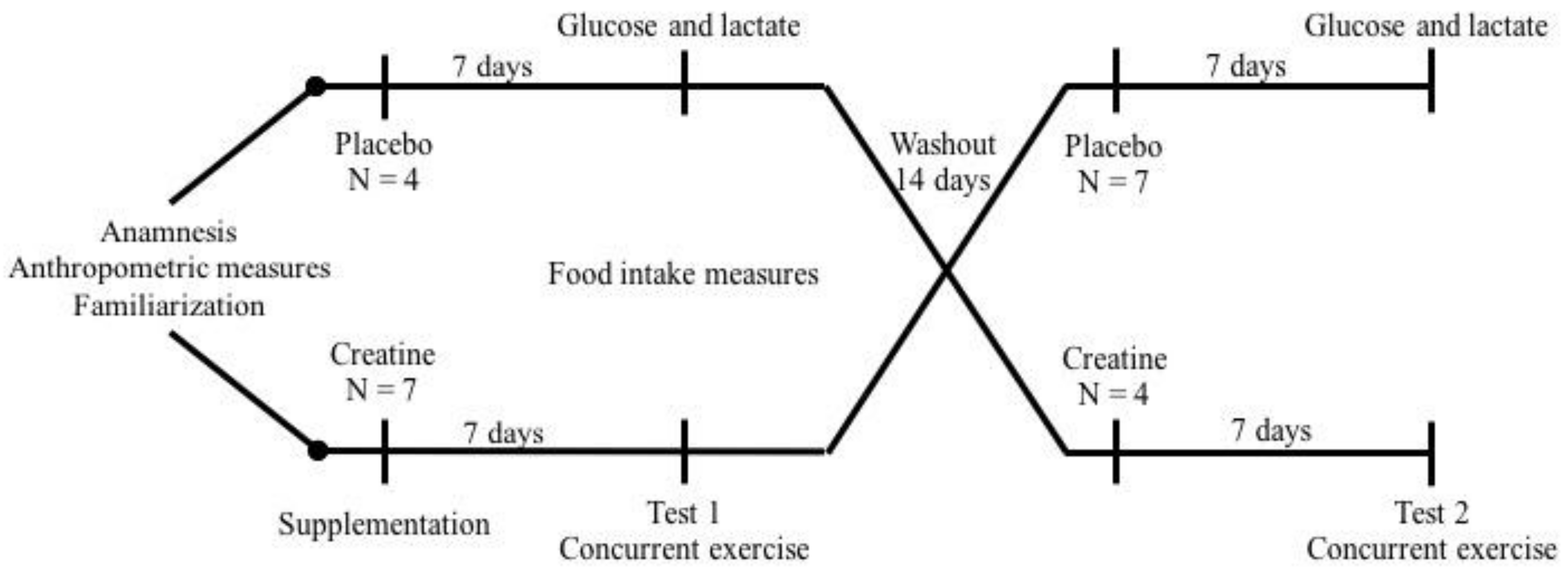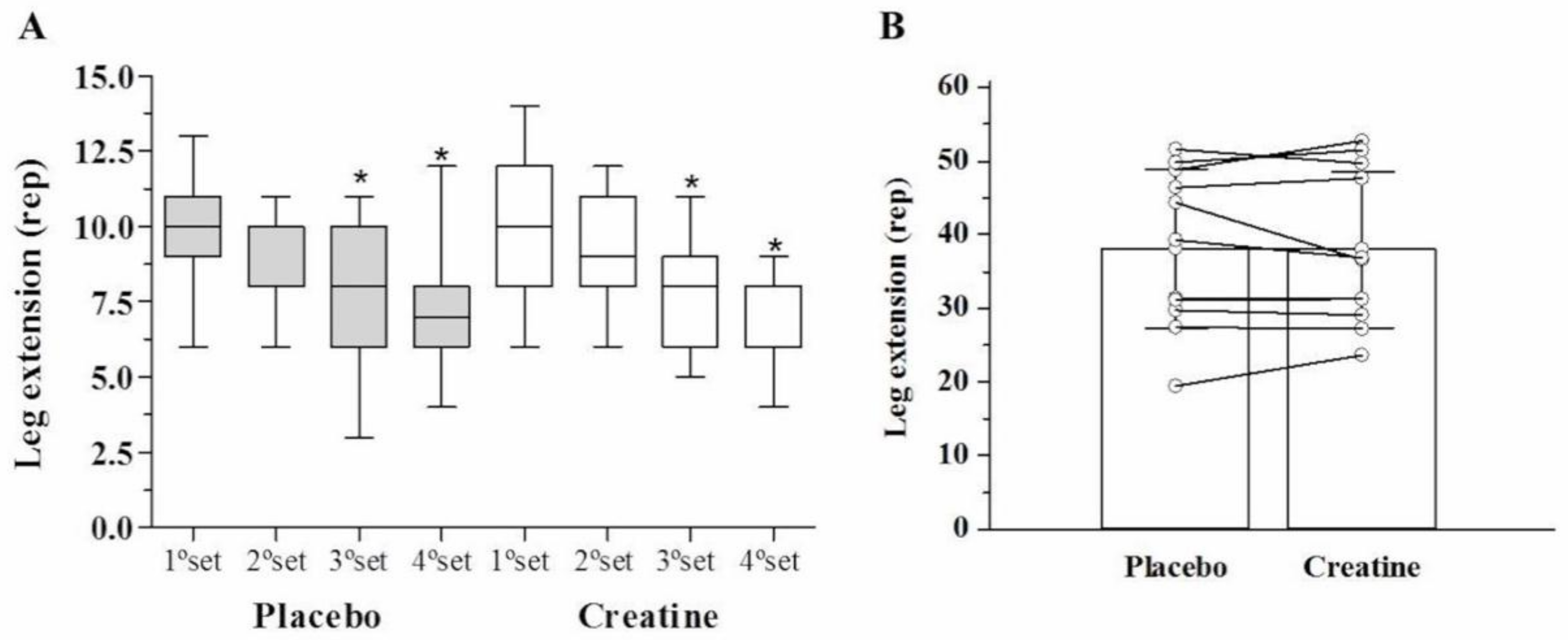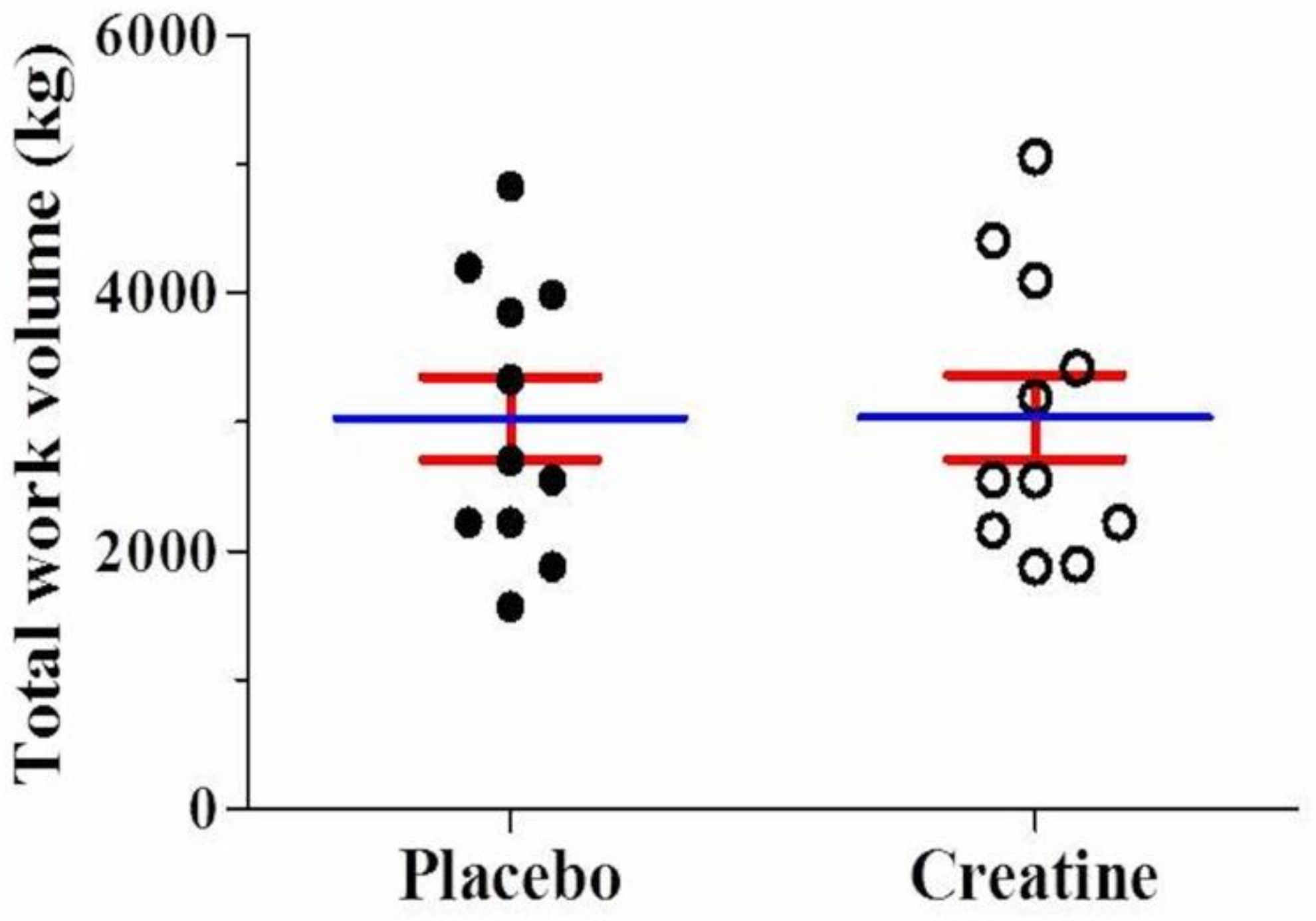Effects of Creatine Supplementation on Lower-Limb Muscle Endurance Following an Acute Bout of Aerobic Exercise in Young Men
Abstract
1. Introduction
2. Methods
2.1. Participants
2.2. Study Overview
2.3. Supplementation
2.4. Anthropometric Measures
2.5. Dietary Intake Analyses
2.6. Maximum Graded Test
2.7. Maximum-Repetition Strength (10 RM) and Strength Endurance Test
2.8. Biochemical Analysis
2.9. Statistical Analyses
3. Results
4. Discussion
Study Limitations
5. Conclusions
Supplementary Materials
Author Contributions
Funding
Conflicts of Interest
References
- Coffey, V.G.; Hawley, J.A. Concurrent exercise training: Do opposites distract? J. Physiol. 2017, 595, 2883–2896. [Google Scholar] [CrossRef]
- Leveritt, M.; Abernethy, P.J.; Barry, B.K.; Logan, P.A. Concurrent Strength and Endurance Training. Sport Med. 1999, 28, 413–427. [Google Scholar] [CrossRef] [PubMed]
- Docherty, D.; Sporer, B. A Proposed Model for Examining the Interference Phenomenon between Concurrent Aerobic and Strength Training. Sport Med. 2000, 30, 385–394. [Google Scholar] [CrossRef] [PubMed]
- de Salles Painelli, V.; Alves, V.T.; Ugrinowitsch, C.; Benatti, F.B.; Artioli, G.G.; Lancha, A.H.; Gualano, B.; Roschel, H. Creatine supplementation prevents acute strength loss induced by concurrent exercise. Eur. J. Appl. Physiol. 2014, 114, 1749–1755. [Google Scholar] [CrossRef]
- Ormsbee, M.J.; Willingham, B.D.; Marchant, T.; Binkley, T.L.; Specker, B.L.; Vukovich, M.D. Protein Supplementation During a 6-Month Concurrent Training Program: Effect on Body Composition and Muscular Strength in Sedentary Individuals. Int. J. Sport Nutr. Exerc. Metab. 2018, 28, 619–628. [Google Scholar] [CrossRef]
- Gentil, P.; de Lira, C.A.B.; Filho, S.G.C.; La Scala Teixeira, C.V.; Steele, J.; Fisher, J. High intensity interval training does not impair strength gains in response to resistance training in premenopausal women. Eur. J. Appl. Physiol. 2017, 117, 1257–1265. [Google Scholar] [CrossRef]
- Eddens, L.; Browne, S.; Stevenson, E.J.; Sanderson, B.; van Someren, K.; Howatson, G. The efficacy of protein supplementation during recovery from muscle-damaging concurrent exercise. Appl. Physiol. Nutr. Metab. 2017, 42, 716–724. [Google Scholar] [CrossRef] [PubMed]
- Gomes, R.V.; Aoki, M.S. Suplementação de creatina anula o efeito adverso do exercício de endurance sobre o subseqüente desempenho de força. Rev. Bras. Med. Esporte 2005, 11, 131–134. [Google Scholar] [CrossRef]
- de Souza, E.O.; Tricoli, V.; Franchini, E.; Paulo, A.C.; Regazzini, M.; Ugrinowitsch, C. Acute effect of two aerobic exercise modes on maximum strength and strength endurance. J. Strength Cond. Res. 2007, 21, 1286–1290. [Google Scholar] [CrossRef]
- Kraemer, W.J. Strength Testing: Development and Evaluation of Methodology. In Physiological Assessment of Human Fitness; Human Kinetics: Champaign, IL, USA, 1995; pp. 115–138. [Google Scholar]
- Candow, D.G.; Forbes, S.C.; Chilibeck, P.D.; Cornish, S.M.; Antonio, J.; Kreider, R.B. Effectiveness of Creatine Supplementation on Aging Muscle and Bone: Focus on Falls Prevention and Inflammation. J. Clin. Med. 2019, 8, 488. [Google Scholar] [CrossRef]
- Kreider, R.B.; Kalman, D.S.; Antonio, J.; Ziegenfuss, T.N.; Wildman, R.; Collins, R. International Society of Sports Nutrition position stand: Safety and efficacy of creatine supplementation in exercise, sport, and medicine. J. Int. Soc. Sports Nutr. 2017, 14, 18. [Google Scholar] [CrossRef] [PubMed]
- Steele, J.; Fisher, J.; Giessing, J.; Gentil, P. Clarity in reporting terminology and definitions of set endpoints in resistance training. Muscle Nerve 2017, 56, 368–374. [Google Scholar] [CrossRef]
- Jackson, A.S.; Pollock, M.L. Generalized equations for predicting body density of men. Br. J. Nutr. 1978, 40, 497–504. [Google Scholar] [CrossRef]
- Fisberg, R.M. Inquéritos Alimentares: Métodos E Bases Científicas; Manole: São Paulo, Brazil, 2005. [Google Scholar]
- USDA Food Composition Databases. Available online: https://ndb.nal.usda.gov/ndb/ (accessed on 15 August 2018).
- Noakes, T.D.; Myburgh, K.H.; Schall, R. Peak treadmill running velocity during the VO2 max test predicts running performance. J. Sports Sci. 1990, 8, 35–45. [Google Scholar] [CrossRef] [PubMed]
- Kraemer, W.J.; Patton, J.F.; Gordon, S.E.; Harman, E.A.; Deschenes, M.R.; Reynolds, K. Compatibility of high-intensity strength and endurance training on hormonal and skeletal muscle adaptations. J. Appl. Physiol. 1995, 78, 976–989. [Google Scholar] [CrossRef] [PubMed]
- Hill, E.C.; Housh, T.J.; Smith, C.M.; Schmidt, R.J.; Johnson, G.O. Gender- and Muscle-Specific Responses During Fatiguing Exercise. J. Strength Cond. Res. 2018, 32, 1471–1478. [Google Scholar] [CrossRef]
- Johannsmeyer, S.; Candow, D.G.; Brahms, C.M.; Michel, D.; Zello, G.A. Effect of creatine supplementation and drop-set resistance training in untrained aging adults. Exp. Gerontol. 2016, 83, 112–119. [Google Scholar] [CrossRef]
- Parise, G.; Mihic, S.; MacLennan, D.; Yarasheski, K.E.; Tarnopolsky, M.A. Effects of acute creatine monohydrate supplementation on leucine kinetics and mixed-muscle protein synthesis. J. Appl. Physiol. 2001, 91, 1041–1047. [Google Scholar] [CrossRef]
- Greenhaff, P.L.; Casey, A.; Short, A.H.; Harris, R.; Soderlund, K.; Hultman, E. Influence of oral creatine supplementation of muscle torque during repeated bouts of maximal voluntary exercise in man. Clin. Sci. 1993, 84, 565–571. [Google Scholar] [CrossRef]
- Pasiakos, S.M.; Lieberman, H.R.; McLellan, T.M. Effects of protein supplements on muscle damage, soreness and recovery of muscle function and physical performance: A systematic review. Sports Med. 2014, 44, 655–670. [Google Scholar] [CrossRef]
- Morton, R.W.; Murphy, K.T.; McKellar, S.R.; Schoenfeld, B.J.; Henselmans, M.; Helms, E. A systematic review, meta-analysis and meta-regression of the effect of protein supplementation on resistance training-induced gains in muscle mass and strength in healthy adults. Br. J. Sports Med. 2018, 52, 376–384. [Google Scholar] [CrossRef]
- Schoenfeld, B.J.; Aragon, A.A.; Krieger, J.W. The effect of protein timing on muscle strength and hypertrophy: A meta-analysis. J. Int. Soc. Sports Nutr. 2013, 10, 53. [Google Scholar] [CrossRef] [PubMed]
- Vandenberghe, K.; Goris, M.; Van Hecke, P.; Van Leemputte, M.; Vangerven, L.; Hespel, P. Long-term creatine intake is beneficial to muscle performance during resistance training. J. Appl. Physiol. 1997, 83, 2055–2063. [Google Scholar] [CrossRef] [PubMed]
- Lemon, P.W.R. Dietary creatine supplementation and exercise performance: Why inconsistent results? Can. J. Appl. Physiol. 2002, 27, 663–681. [Google Scholar] [CrossRef] [PubMed]
- Wyss, M.; Kaddurah-Daouk, R. Creatine and creatinine metabolism. Physiol. Rev. 2000, 80, 1107–1213. [Google Scholar] [CrossRef]
- Jung, S.; Bae, Y.S.; Kim, H.J.; Jayasena, D.D.; Lee, J.H. Carnosine, anserine, creatine, and inosine 5 ′-monophosphate contents in breast and thigh meats from 5 lines of Korean native chicken. Poult Sci. 2013, 12, 3275–3282. [Google Scholar] [CrossRef]
- Syrotuik, D.G.; Bell, G.J. Acute Creatine Monohydrate Supplementation: A Descriptive Physiological Profile of Responders vs. Nonresponders. J. Strength Cond. Res. 2004, 18, 610–617. [Google Scholar] [CrossRef]



| Characteristics | Mean ± SD |
|---|---|
| Age (years) | 26.5 ± 6.2 |
| Body weight (kg) | 77.6 ± 7.2 |
| Height (m) | 1.7 ± 0.0 |
| Body mass index (kg/m2) | 26.6 ± 2.1 |
| Body fat (%) | 14.4 ± 6.6 |
| Work volume leg extension (kg) | 88.1 ± 18.6 |
| Total work volume (kg) | 3030.5 ± 1068.2 |
| Effort time run for 5 km (min) | 25.5 ± 2.6 |
| Nutrients | Mean ± SD |
|---|---|
| Total calories (kcal) | 2196.6 ± 702.9 |
| Carbohydrate (%) | 43.6 ± 8.2 |
| Carbohydrate (g/kg) | 3.0 ± 1.0 |
| Protein (%) | 26.4 ± 4.3 |
| Protein (g/kg) | 1.5 ± 0.3 |
| BCAA (g) | 19.0 ± 6.1 |
| Leucine (g) | 8.3 ± 2.9 |
| Valine (g) | 5.8 ± 1.8 |
| Isoleucine (g) | 4.8 ± 1.5 |
| Lipids (%) | 29.9 ± 9.5 |
© 2020 by the authors. Licensee MDPI, Basel, Switzerland. This article is an open access article distributed under the terms and conditions of the Creative Commons Attribution (CC BY) license (http://creativecommons.org/licenses/by/4.0/).
Share and Cite
Vieira, I.P.; de Paula, A.G.; Gentil, P.; Pichard, C.; Candow, D.G.; Pimentel, G.D. Effects of Creatine Supplementation on Lower-Limb Muscle Endurance Following an Acute Bout of Aerobic Exercise in Young Men. Sports 2020, 8, 12. https://doi.org/10.3390/sports8020012
Vieira IP, de Paula AG, Gentil P, Pichard C, Candow DG, Pimentel GD. Effects of Creatine Supplementation on Lower-Limb Muscle Endurance Following an Acute Bout of Aerobic Exercise in Young Men. Sports. 2020; 8(2):12. https://doi.org/10.3390/sports8020012
Chicago/Turabian StyleVieira, Itamar P., Amanda G. de Paula, Paulo Gentil, Claude Pichard, Darren G. Candow, and Gustavo D. Pimentel. 2020. "Effects of Creatine Supplementation on Lower-Limb Muscle Endurance Following an Acute Bout of Aerobic Exercise in Young Men" Sports 8, no. 2: 12. https://doi.org/10.3390/sports8020012
APA StyleVieira, I. P., de Paula, A. G., Gentil, P., Pichard, C., Candow, D. G., & Pimentel, G. D. (2020). Effects of Creatine Supplementation on Lower-Limb Muscle Endurance Following an Acute Bout of Aerobic Exercise in Young Men. Sports, 8(2), 12. https://doi.org/10.3390/sports8020012








